by Martin Green
I recently decided that I “needed” an upscale, stainless steel sports watch. Of course, there was no actual “need” for a stainless steel sports watch. In fact, there was no need for another watch at all. But that didn’t stop me wanting one anyway.
It is also still not clear – not even to myself – why it had to be an “upscale” sports watch along the lines of an Audemars Piguet Royal Oak or Patek Philippe Nautilus. Would it outperform my Cartier Santos in any way – and in sufficient manner for the investment to be justified?
When you think about it rationally, there are already plenty of arguments to stop then and there, but the beauty of watches is that it doesn’t have to be rational. Beauty might be one of the very few areas in life where we can be completely irrational and still come out on top . . . as I felt when my quest was concluded.
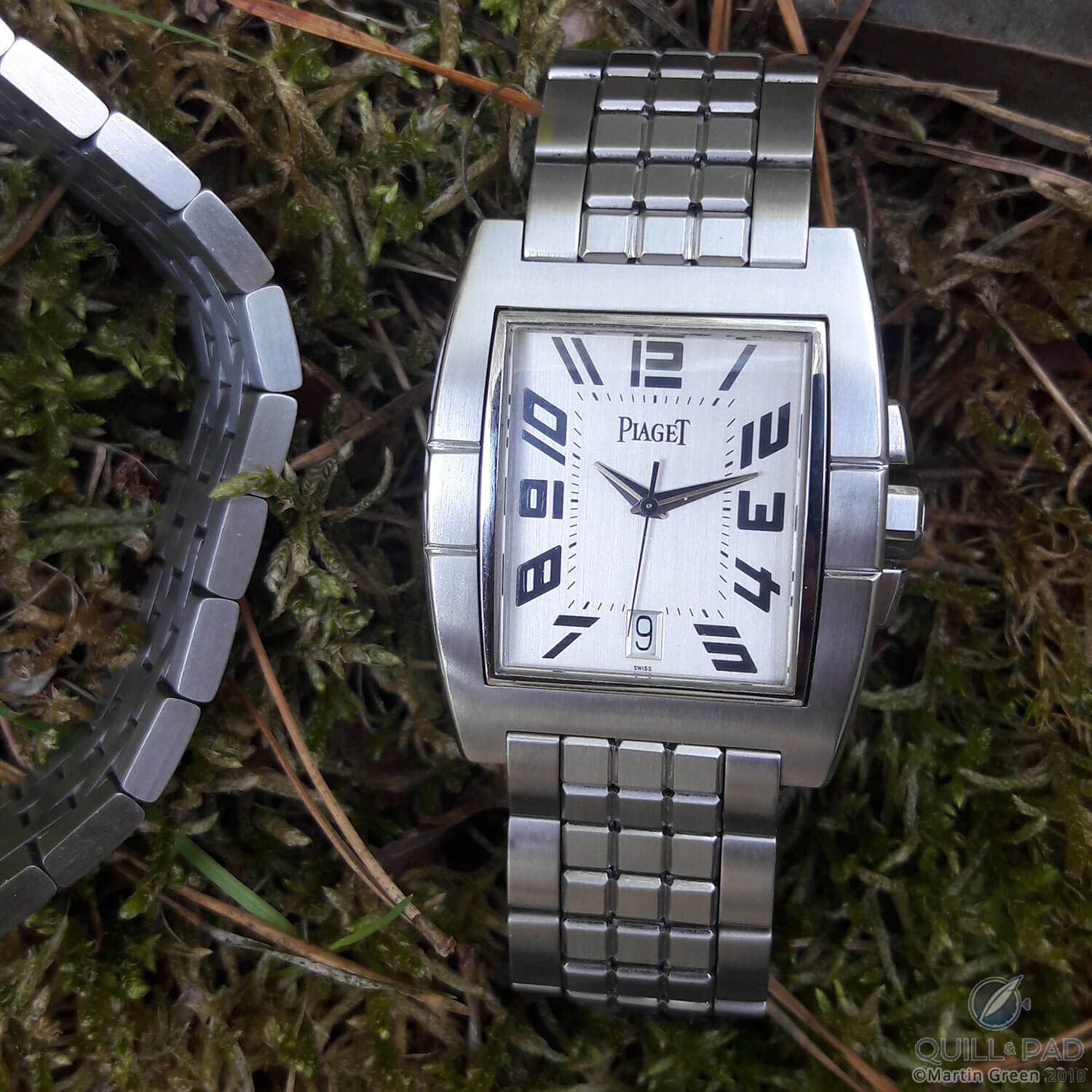
Piaget Upstream
Not a sports watch kind of guy
As the resident gentleman of Quill & Pad, you can guess that I am not really a sports watch kind of guy. That’s a good thing when you go shopping for an upscale, stainless steel sports watch because the vast majority are made for the spectators and not the athletes themselves.
The term “sports watch” in this case only refers to the “everyday” material its case is made of. In essence, sports watches are about as “sporty” as a politician is “blue collar.” They feature refined movements and an in-house example was one of the first requirements that I listed on paper.
I guess that most people buying an upscale sports watch are not sports watch kinds of guys or gals either. Most contenders in this rather fluid segment are fitted with slim, if not ultra-thin, movements, allowing for modest case profiles – resulting in timepieces that look like sports watches, but should by no means be worked out in.
Not a holy trinity kind of guy, either
While it does depend on who you ask, when it comes to stainless steel, upscale sports watches most people would name the Audemars Piguet Royal Oak, Patek Philippe Nautilus, and Vacheron Constantin Overseas as the “holy trinity” in this field.
While I have great respect for the Nautilus, I have always favored the design of the Aquanaut. Sacrilegious? Maybe, but buying a watch is a very personal matter.
That’s what keeps such a large variety of different brands with different-looking watches in business. The downside of the Aquanaut is, however, the second requirement I noted: the stainless steel bracelet. While well-made and finished, the bracelet of the Aquanaut is by no means as enticing as the integrated bracelet of the Nautilus. I think that the Aquanaut fares far better on its rubber strap, which would make an excellent choice if that was my thing.
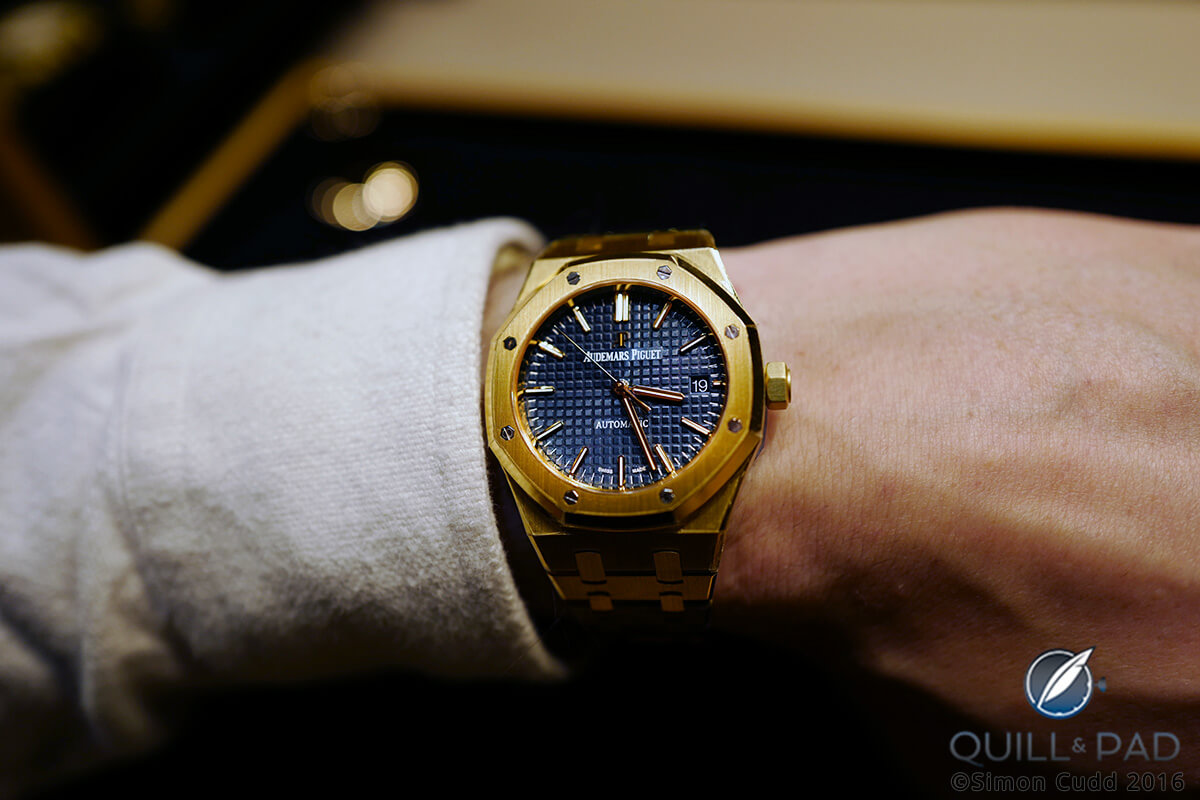
Audemars Piguet Royal Oak Selfwinding in yellow gold
I have always thought that the Royal Oak was a wonderful creation, and when I went down to an Audemars Piguet dealer and tried on the 15400, it ticked all the boxes . . . unfortunately not only for me. It might have been fate, but that week I encountered three different people wearing time-only Royal Oaks!
I have always had an adverse response to peer pressure: when a lot of people have something, I don’t want it. Despite still considering the Royal Oak a thing of great beauty, I saw no point in getting an exclusive, upscale sports watch that was apparently not that exclusive.
With Vacheron Constantin’s Overseas I am talking about the previous generation, and while the time-only version looked nice on my wrist, that was it. There was no lightning bolt, no goosebumps, just a really nice watch secured to my wrist. That just wasn’t enough.
When fate intervenes
The whole process took several months. Part of the fun of getting a new watch is to decide what you are going to get. Earlier on in my collecting days, I made a few spur-of-the-moment, highly impulsive buys and learned the hard way that those watches never end up getting a lot of wrist time. After that I not only took my time, but I also learned to enjoy spending time to hunt down the right watch for me.
At some point, I did a photo shoot at a local Parmigiani dealer, who, as it turned out, also sold gently used watches as a service to his clients. It was there that I came eye to eye with the Piaget Upstream. The lightning bolt struck, and I had found my upscale, stainless steel sports watch!
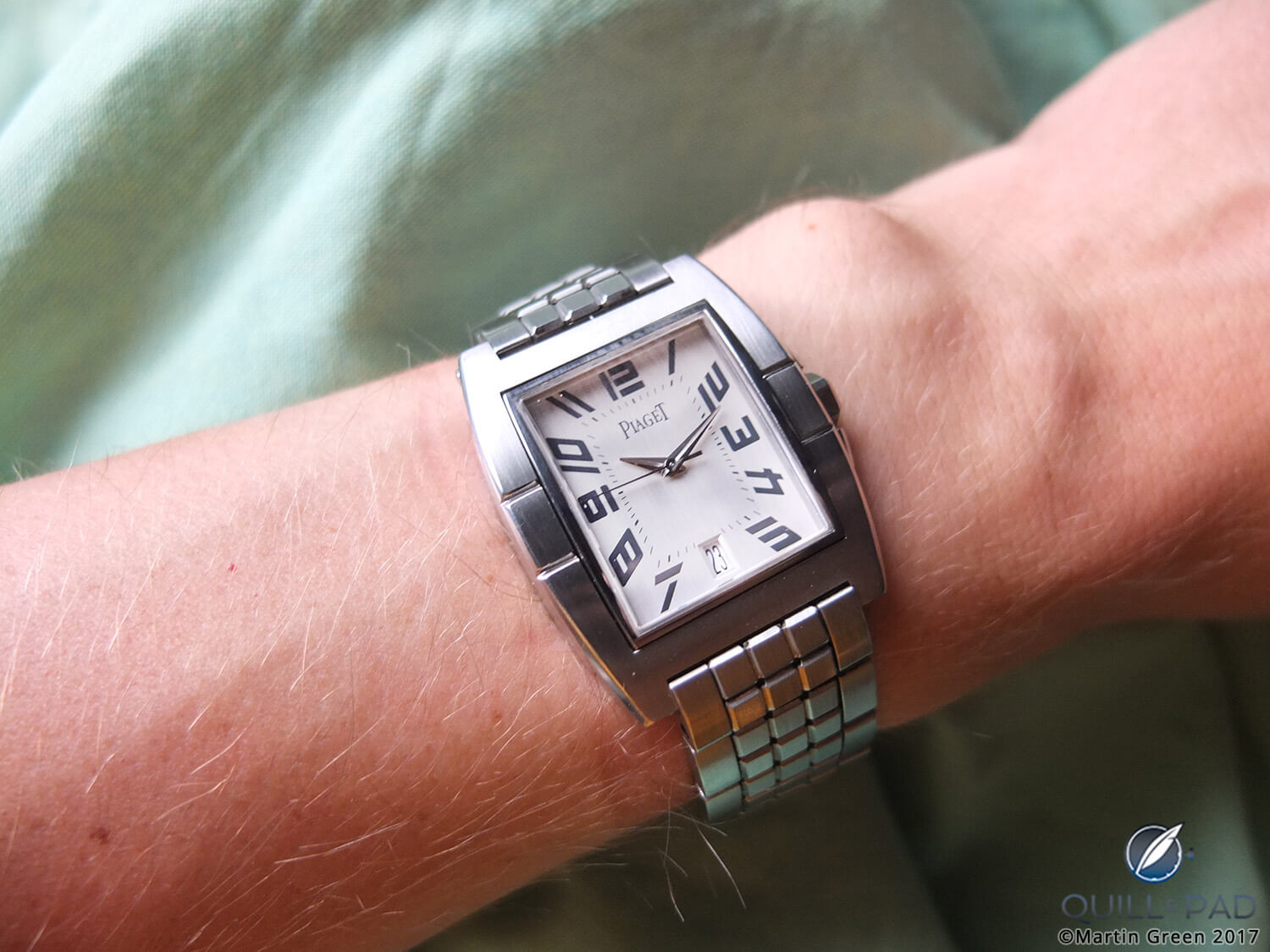
Piaget Upstream on the wrist
Piaget Upstream: such a fitting name
The Upstream never gained the traction Piaget had hoped for among the watch-buying public. In fact, it is almost embarrassing that I myself didn’t consider it sooner as dress watches are my thing, and quite a few of the watches in this genre are indeed made by Piaget.
The largest issue – perhaps even the only issue – with the Upstream is that it came a little too late. It took the brand until the year 2000 to add this watch to its collection as its first offering in stainless steel in over half a century. While not an excuse, it does make sense; Piaget is a master in gold, having created many incredible, ultra-thin gold watches and was even chosen by Salvador Dalí himself to craft jewelry and watches based on his exotic designs.
Piaget excelled to such an extent in all this that it became highly specialized. This brought the historic brand periods of great success but made it very vulnerable in several ways.
First of all, it was late in making the transition and didn’t follow the lead of its colleagues in the 1970s when the Royal Oak and the Nautilus were launched because it was still doing brisk business with its gold watches.
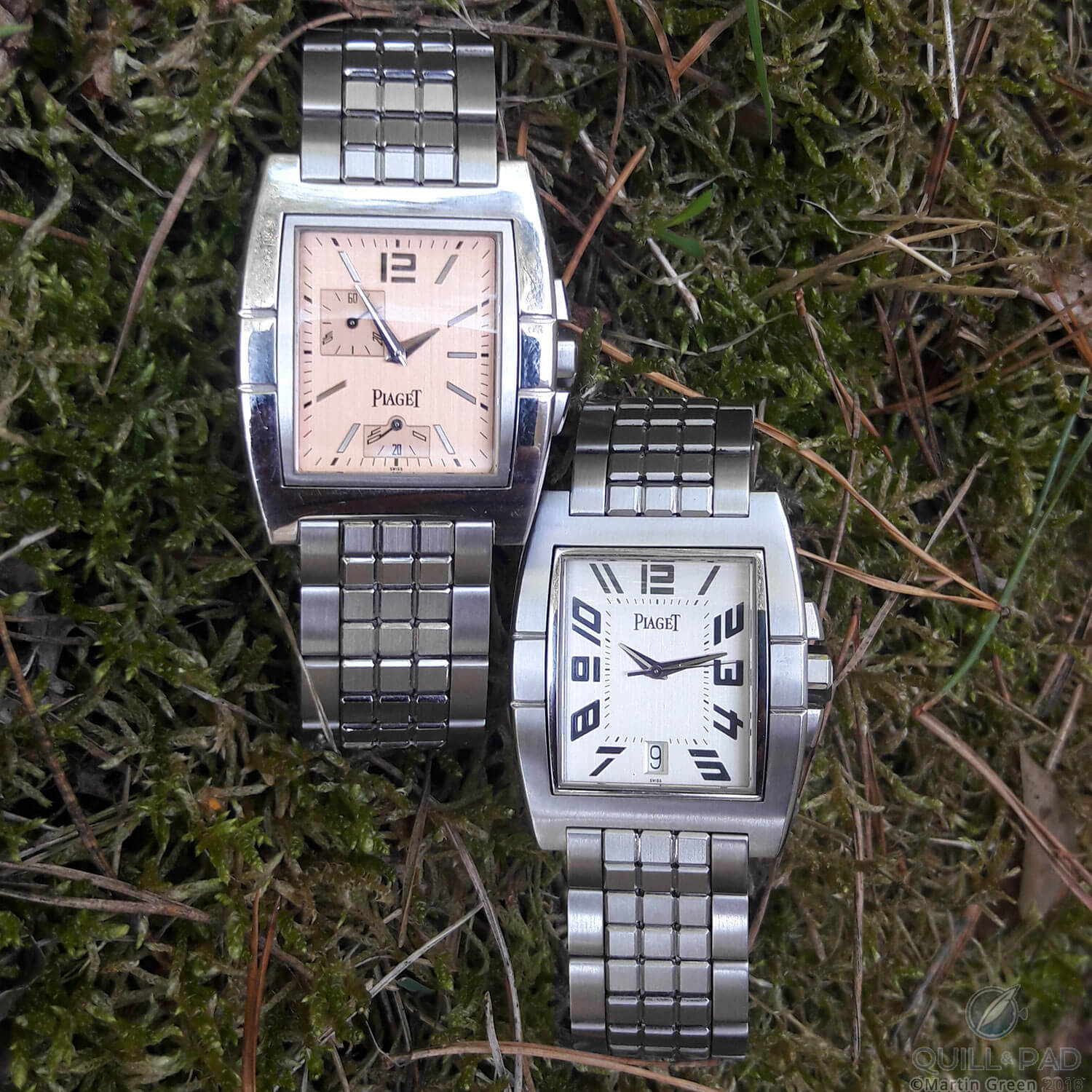
Piaget Upstreams with salmon-colored and white dials
Only when it became clear that the demand for classic gold watches was likely to be decreasing did Piaget join the game. Because it was so late and because it was so specialized in gold, not many people took the Upstream seriously. In a way, the name could not have been more fitting as the brand was indeed swimming upstream and had to battle such a strong current that in 2007 the end of this collection arrived.
Why choose the underdog Piaget Upstream?
Why would I choose such an underdog? A watch that came late to the party and left before it ended? Is my “aversion to peer pressure” behind this decision, or is the Upstream such a good watch that it is a top dog masquerading as the underdog?
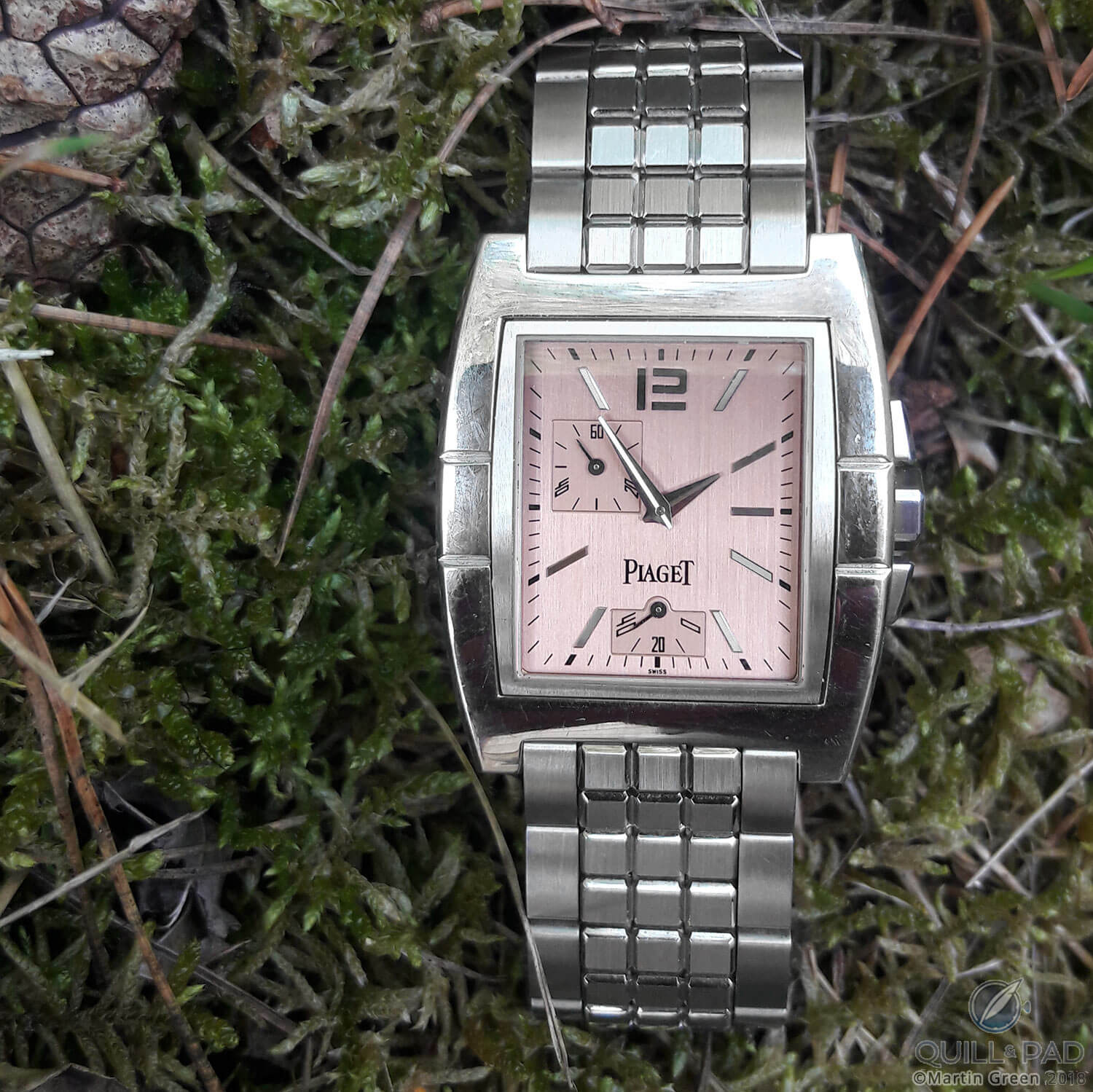
Piaget Upstream
I am of course a strong believer in the latter as I otherwise would have never bought the watch.
It is no secret that when a watch is successful, it gets copied. And while Piaget had every reason to do that at the time, the brand took the high road and created a design we hadn’t seen before.
While Piaget could have settled for creating a tonneau-shaped case, it went one step further and integrated the clasp into the case. And it was indeed something of a technical nightmare for Piaget to take this from concept to production, but persevere the brand did, adding not only a truckload of character to the watch but also making it extremely comfortable to wear.
The bracelet itself has a very sophisticated construction, and because of the unique way the clasp works it fits seamlessly on the wrist when closed.
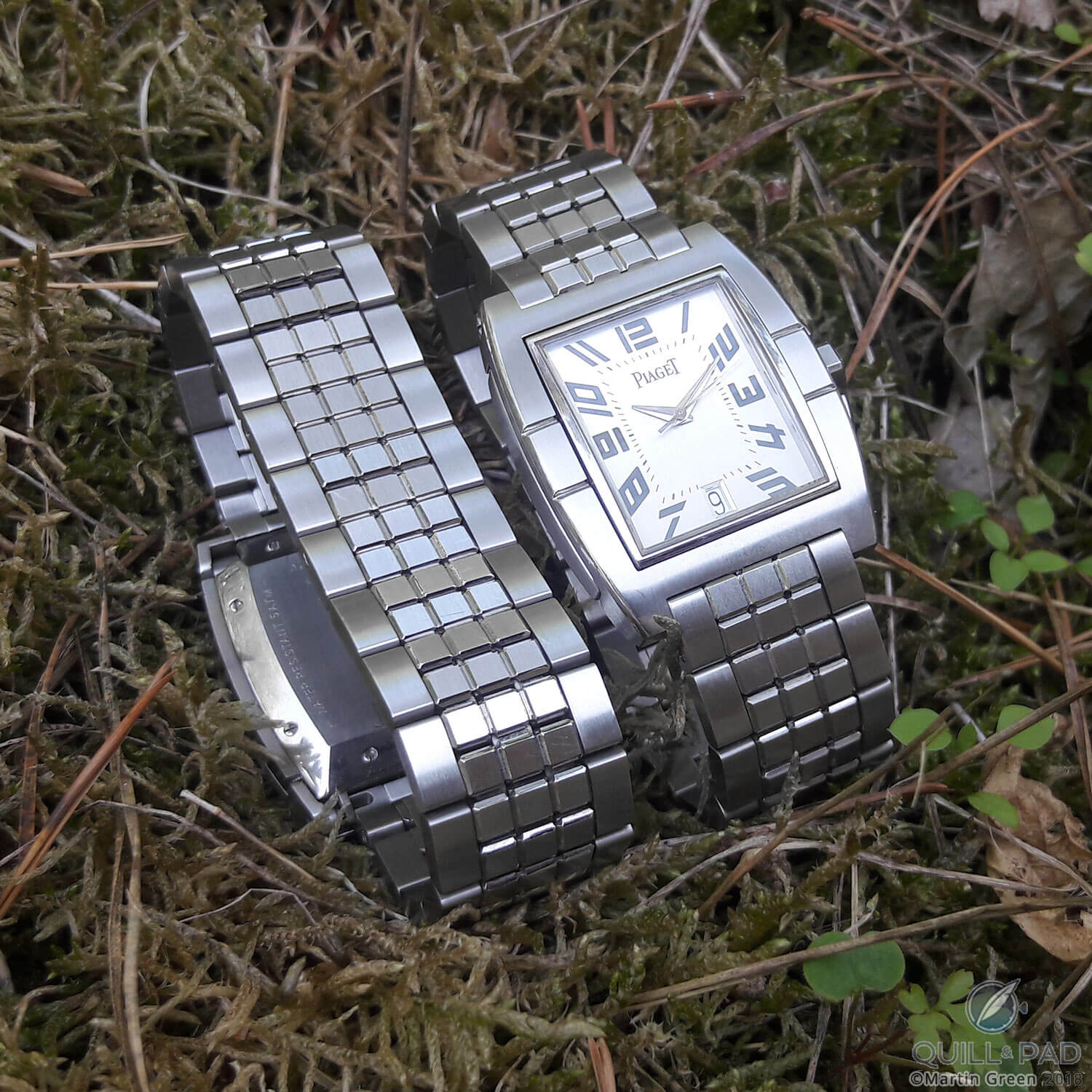
Piaget Upstream
The bracelet also has another quality, showcasing Piaget’s experience as a jewelry maker: the inner segments comprising three squares have a brushed finish on top, but the slanted sides are polished. Accomplishing this must have been a nightmare for the polishers, but the result is a beautiful play of light that highlights the unique look of the bracelet.
The dial is also unique as Piaget opted for a rather high-tech-looking font. In combination with the tonneau-shaped case and the design of the stainless steel bracelet, it most certainly reaches a state of synergy.
As Piaget is usually a brand that supplies other brands with movements, it also met with another demand on my requirement list: a manufacture movement. Caliber 504P features a full-sized oscillating weight mounted in the center of the movement, which has a height of 3.5 millimeters. Ultra-thinness was not a top priority when Piaget developed this movement: the brand mainly utilizes it in watches that are naturally thick by design.

Piaget Upstream on the wrist (photo courtesy Geo Cramer)
While the movement is wonderfully decorated with beveled bridges, a circular-grained base plate, circular côtes de Genève, and blued screws, Piaget made the right decision to keep that for the enjoyment of the watchmaker, withstanding the temptation to put a round sapphire crystal in the tonneau-shaped case back. Sometimes it is enough to know that things are good and beautiful; you don’t necessarily have to see them.
While it might not have been the case for everybody, I know that my choice for the Piaget Upstream has been the right one for me. Why? Because it stopped the craving!
While I still admire the many upscale, stainless steel sports watches that I have the privilege to handle throughout the year, I do not need to own them.
Not that this got me completely out of the woods, though – because I am so pleased with my Upstream, I’m now on the lookout for the rare power reserve version, which was only released in a few limited editions, none of which was more than 100 pieces . . .
I am so happy that getting another watch is not a rational contemplation!
Quick Facts Piaget Upstream
Case: 40 x 33 mm, stainless steel with stainless steel bracelet and clasp integrated into the case
Movement: automatic Caliber 504P, 3 Hz/21,600 vph, 3.5 mm high, power reserve 42 hours
Functions: hours, minutes, seconds; bidirectionally settable date
Years of manufacture: 2000-2007
Original retail price: $6,100
You may also enjoy
60 Years Of Piaget Altiplano: Sophisticated Style Versus Fugitive Fashion
A History Of Vacheron Constantin’s Overseas Line, Culminating in 2016’s Worldtimer
Leave a Reply
Want to join the discussion?Feel free to contribute!





















































Hi guys hope you are well!!
I have little bit difficulty with Piaget watch which is really old. Piaget upstream/quartz/flyback chronograph
Can you help me to adjust the time?
Hi mate, a really good watch!
Any may I know for your power reserve upstream, the color is quite unique, and I haven’t see this color for this model before. May I know is it actual the silver dial but color change because the years?
Thank you for a good review and Nice pictures. Congratulations on your watch purchase! I am considering purchasing one myself in the antracite dial color. Do you know what service costs are? Have you had it serviced, and if so, what was your experience with piaget service? Thank you.
Grretings from Denmark
Hi i have an upstream like yours and im very happy, nice to see people appreciate the watch. Its funny because i also complement with a cartier Santos.
I had my watch in service, they sent it to piaget for 4 weeks about. I think they changed a few things and the cost almost 1000 euro. My Santos service was 500 euro so the piaget service was pretty high.
Anyway didnt regret it the watch Works wonderfully:)
I enjoyed your article. This is an incredible watch and I recommend readers seek photographs or videos demonstrating the clasp in action. It is truly unique!